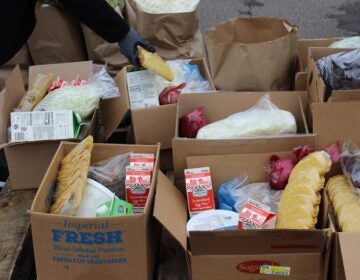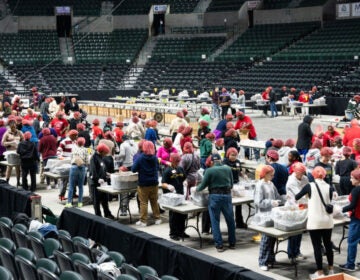N.J. food banks build stockpiles, bracing for a COVID-19 winter
One executive fears a "perfect storm" with higher demand amid the possibility of more business closures and job losses.
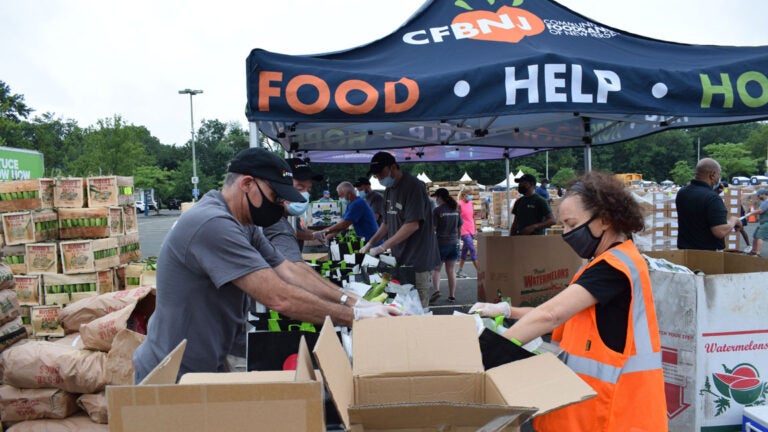
A Community FoodBank of New Jersey distribution event during the coronavirus pandemic. (CFBNJ)
This story originally appeared on NJ Spotlight.
___
New Jersey’s biggest food bank is doubling its stockpile of food in anticipation of a second wave of COVID-19 this winter, while two other hunger-relief groups are planning for what one executive called a “perfect storm” of renewed business closures, a shortfall in government jobless aid and bottlenecks in the food supply chain.
The Community FoodBank of New Jersey, which operates in 15 counties, is buying enough food to make an extra 5 million meals, in addition to the 5 million-meal stockpile it has been maintaining since the pandemic began.
With a steady rise in the number of COVID-19 infections statewide since the start of September, and fears of a further increase as the weather gets colder, the state’s three main food banks are bracing for a new surge in demand if the coronavirus drives another jump in unemployment — the biggest determinant of demand for food assistance.
“What we want to do is make sure we have more than one month of product on hand so that if needed we can release,” said Carlos Rodriguez, president of the Community FoodBank.
The biggest source of food for the Community FoodBank now is the federal government, which currently supplies 63% of its stock. Before the pandemic, the government supplied less than 50% but the proportion has increased to help make up for a sharp decline in food donated by supermarkets, which have had their own supply-chain problems and now make up 26% of the total.
The food bank makes up the rest of the shortfall by purchasing food, which now accounts for 10% of the total, Rodriguez said. That’s double what it needed to buy before the pandemic, he said. The cost of buying the added food has been paid for by an increase in state funding.
Vital state funding
“We’re in a position where if we needed more food, we could buy some more food,” he said. “Some of the recent state funding really does prepare us for that, and that’s why we were all asking for continued funding because we knew something was going to change. The something is a surge in COVID-19 cases or the amplification of need because of the economic crisis.”
With the current stockpiling of food, he’s confident he will be able to meet demand for the rest of 2020 but expects to revisit the issue of sourcing in January.
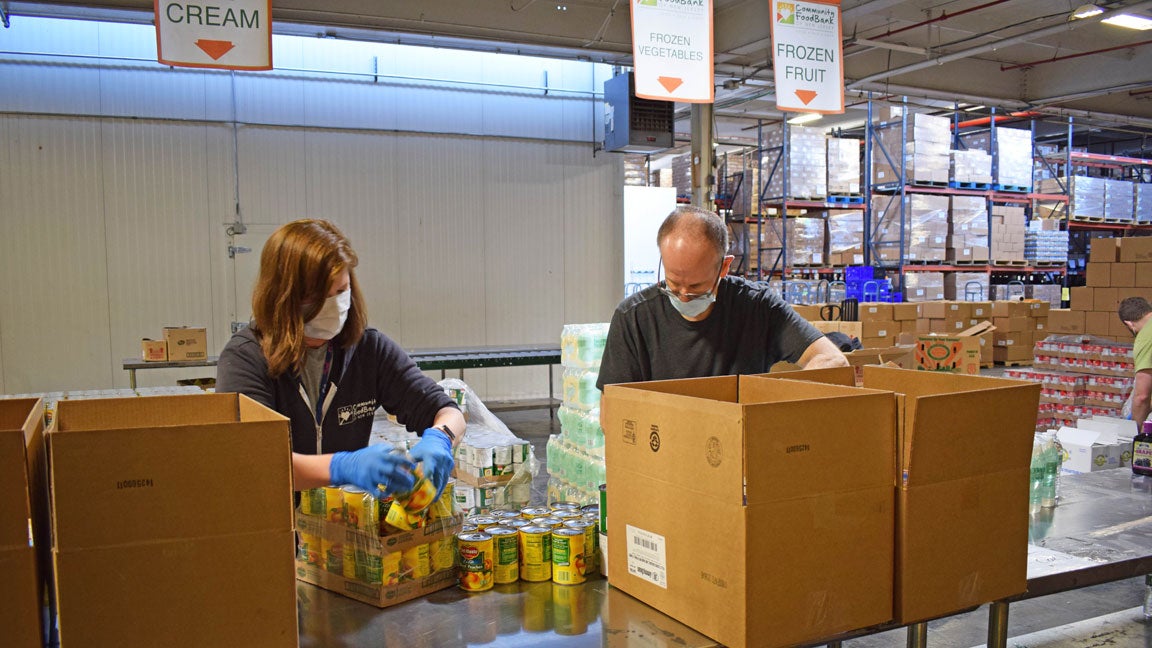
According to data from the food bank, one in seven people, or about 860,000, in its service area are now “food insecure” — meaning they don’t have consistent access to nutritious food — up from one in 11 people, or about 550,000, before the pandemic. The state’s unemployment rate of 10.9% in August, the latest month to be officially reported, is below its pandemic highs but about three times its pre-COVID-19 level.
Supplies from food banks are distributed to people in need by hundreds of pantries, soup kitchens and other volunteer groups that are also seeing an unprecedented rise in demand for their services. They include Catholic Charities, whose three pantries — in Paterson, Dover and Franklin — serve about 5,000-7,000 people a month, or five times the pre-pandemic number.
“Throughout the last six months, we have helped more people than any time before in our 80-year history,” said Chris Brancato, development director for Catholic Charities. “All of our many programs are in need during this critical time, including our food pantries which are completely funded by donations.”
Sharp increase in costs
Meanwhile, food banks are faced with sharply higher prices because of pandemic-related problems in the food supply chain. At Fulfill, serving Monmouth and Ocean counties, the cost of food purchases has jumped 445% since the pandemic started, said president Kim Guadagno.
The monthly bill for food has gone from $175,000 before the pandemic to $600,000 and the price of a truckload of canned vegetables has risen to $65,000 from $22,000 pre-pandemic, she said.
“Most of it is, you can’t find the cans to put the mixed vegetables in,” she said. “COVID has impacted the ability of drivers to drive and the food to get where it needs to be. If you go into the grocery store now, you will see an uptick in costs; the same thing happens with food banks.”
Guadagno is bracing for a new increase in demand for food from people who have been laid off from the many restaurants and hospitality businesses that are now closing with the end of the Jersey Shore’s summer season, or because they can’t make ends meet because of the restrictions on indoor dining and the coming end of outdoor dining as the weather gets colder.
“If we don’t expand the inside business and figure out some way to continue service, then you’re going to see busboys and cooks and bartenders and cleaning people all come back to pantries for survival,” she said. “We’re going to see a surge there, and we’re planning on seeing even more now because these restaurants are going to close for good. Also, we believe the virus is coming back.”
During the pandemic, Fulfill has been distributing at least 40% more food than it did before, with an expected increase to more than 50% by the end of this year. Guadagno has made up for a drop in donor funding with money from state and federal governments, and she thinks she will have enough to meet demand at the anticipated level. But she doubts she will be able to respond if there’s a bigger-than-anticipated increase in COVID-19 infections or unemployment.
“If we do, I don’t know where we’re going to get the money to pay for it,” she said.
The ‘perfect storm’
At the Food Bank of South Jersey, which serves four counties, president Fred Wasiak is planning for what he called a “perfect storm” of conditions that could result in a big new surge in demand for food assistance.
His food bank is already serving about 90,000 people a month, or 50% more than it did a year ago, and Wasiak is thinking about how he will keep people fed if Congress fails to agree on new unemployment assistance to replace the $600-a-week checks that ended in July, or if a new wave of COVID-19 closes more businesses.
Many of his clients have never used food banks before. “They say ‘Thank you for being here, I never thought I would have to be in this line; I never knew food insecurity before, and I never knew a food bank like this existed,’” Wasiak said. “The children are in the back seat with ‘thank you’ signs.”
To reduce the risk of COVID-19 transmission, the food bank recently stopped making its own food boxes, and now buys pre-packaged food boxes that are designed to feed a family of four for three or four days. Those boxes are given out at 28 mobile distribution events each month.
Wasiak and other food-bank leaders are also considering how they will respond if there’s a surge in evictions of tenants and homeowners unable to pay rent or mortgages because of the pandemic but who have been temporarily shielded from eviction by an executive order from Gov. Phil Murphy. If those people are suddenly made homeless after the public health crisis is declared at an end, many are expected to turn to food pantries and soup kitchens to feed themselves.
“We’re anticipating if that happens on top of another large spike of COVID, that’s what I’m calling the perfect storm,” he said. “We have pivoted, we have grown, we have re-strategized; now we’re just preparing for what may come.”
In the short term, Wasiak said he hopes he can keep up with demand for holiday-season food. “Last year, we distributed 13,000 turkeys; our goal this year is to get up to 20,000,” he said.
WHYY is your source for fact-based, in-depth journalism and information. As a nonprofit organization, we rely on financial support from readers like you. Please give today.


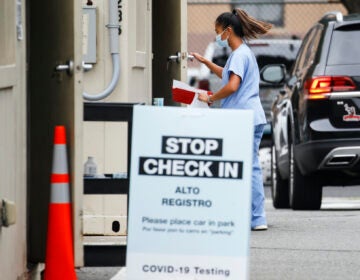
![CoronavirusPandemic_1024x512[1]](https://whyy.org/wp-content/uploads/2020/03/CoronavirusPandemic_1024x5121-300x150.jpg)
